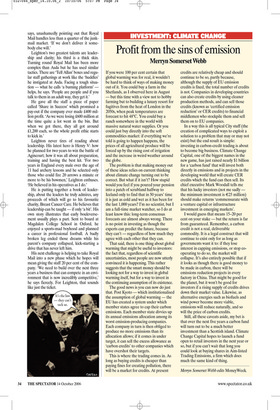Profit from the sins of emission
Merryn Somerset Webb
If you were 100 per cent certain that global warming was for real, it wouldn’t be hard to think of ways of making money out of it. You could buy a farm in the Shetlands, as I observed here in August — but this time with a view not to hobby farming but to building a luxury resort for fugitives from the heat of London in the 2050s, when peak temperatures are forecast to hit 48°C. You could buy a ranch somewhere in the world with massive natural water supplies. Or you could just buy directly into the soft commodities market: if everything we’re told is going to happen happens, the prices of all agricultural produce will be forced up by the rising cost of irrigation and the increase in weird weather around the globe.
The problem is that making money out of these ideas relies on current thinking about climate change turning out to be correct. But what if it isn’t? How stupid would you feel if you poured your pension into a patch of scrubland halfway to Iceland only to find that in 50 years’ time it is just as cold and wet as it has been for the last 1,000 years? I’m no scientist, but I am a full-time market watcher, so I do at least know this: long-term consensus forecasts are almost always wrong. There is no point in investing as though the experts can predict the future, because they can’t — regardless of how much they agree with each other that they can.
That said, there is one thing about global warming that might be useful to investors: the fact that, regardless of scientific uncertainties, most people are now utterly convinced it is happening. This rather suggests that the smart money should be looking not for a way to invest in global warming itself, but for a way to invest in the continuing assumption of its existence.
The good news is you can now do just that. Post Kyoto — which institutionalised the assumption of global warming — the EU has created a system under which member states agree to cap their carbon emissions. Each member state divvies up its annual emissions allocation among its worst emission-producing companies. Each company in turn is then obliged to produce no more emissions than its allocation allows; if it comes in under target, it can sell the excess allowance as ‘carbon credits’ to other companies which have overshot their targets.
This is where the trading comes in. As long as buying credits is cheaper than paying fines for creating pollution, there will be a market for credits. At present credits are relatively cheap and should continue to be so, partly because, although the supply of EU emission credits is fixed, the total number of credits is not. Companies in developing countries can also create credits by using cleaner production methods, and can sell those credits (known as ‘certified emission reduction’ or CER credits) to financial middlemen who stockpile them and sell them on to EU companies.
In a way this is all typical City stuff (the creation of complicated ways to exploit a solution to a problem that may or may not exist) but the end result is simple: investing in carbon-credit trading is about to become big business. Climate Change Capital, one of the biggest names in the new game, has just raised nearly $1 billion for a ‘carbon fund’ that will invest both directly in emissions and in projects in the developing world that will create CER credits which the fund can then sell. Its chief executive Mark Woodall tells me that his lucky investors (not me sadly the minimum investment is €25 million) should make returns ‘commensurate with a venture capital or infrastructure investment in emerging markets’.
I would guess that means 15–20 per cent on your stake — but the return is far from guaranteed. Remember, a carbon credit is not a real, deliverable commodity. It is a legal construct that will continue to exist only for as long as governments want it to: if they lose interest in capping emissions, or stop cooperating to do so, the market will collapse. It’s also entirely possible that if it looks as though there is good money to be made in carbon, there will be emissions reduction projects in every factory in China. That might be good for the planet, but it won’t be good for investors if a rising supply of credits drives down their market value. Likewise, as alternative energies such as biofuels and wind power become more viable, emissions will reduce naturally, and so will the price of carbon credits.
Still, all these caveats aside, my bet is that over the next five years a carbon fund will turn out to be a much better investment than a Scottish island. Climate Change Capital hopes to launch a fund open to retail investors in the next year or so, but if you can’t wait that long you could look at buying shares in Aim-listed Trading Emissions, a firm which does much the same kind of thing.


































































































 Previous page
Previous page